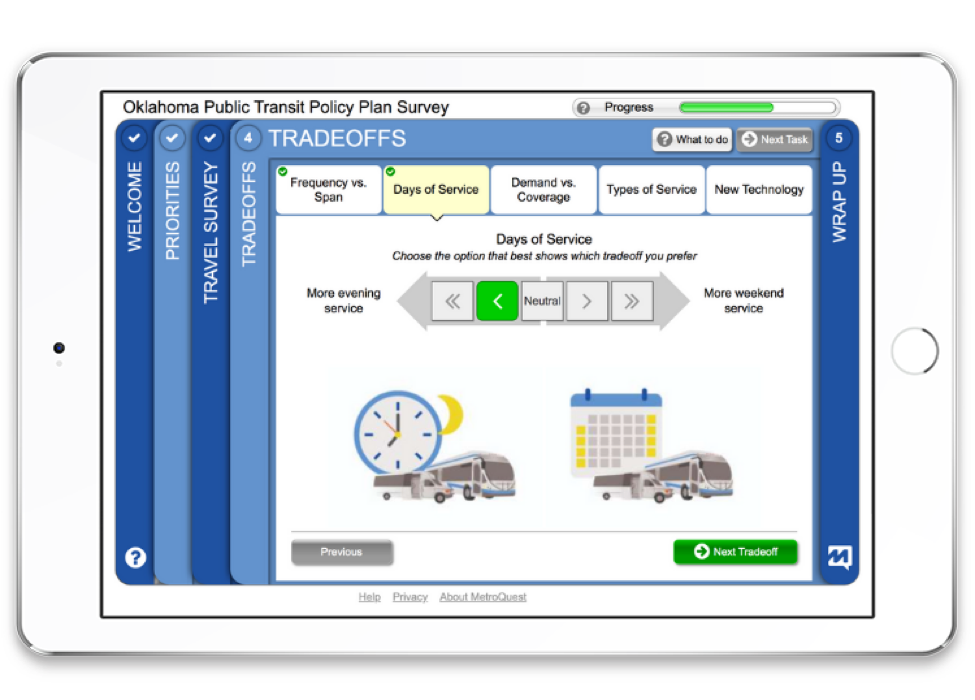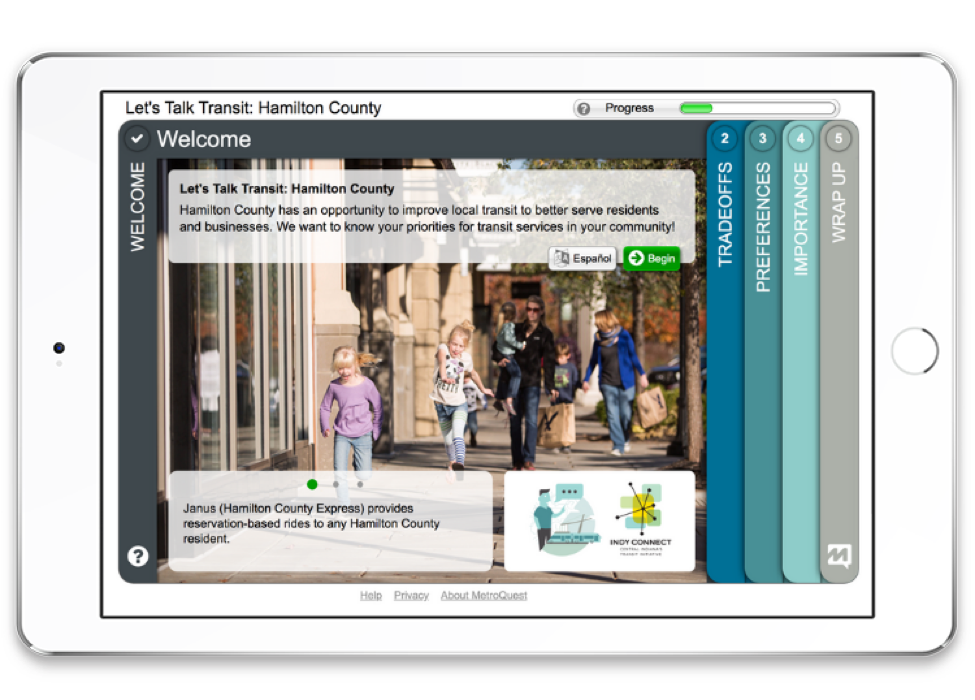Transit Planning: Examples of Tradeoff Education for Community Outreach
![2020-Transit-Planning-byNorma-Header-Image-805by366 [INSIGHTS] Transit Planning: Examples of Tradeoff Education for Community Outreach](https://metroquest.com/wp-content/uploads/2020-Transit-Planning-byNorma-Header-Image-805by366.png)
When gathering input from the public, finding ways to educate them along the way is a crucial aspect that should always be considered. Asking for input from the public on planning projects helps agencies understand their constituents’ priorities – or barriers! In addition, information on current or expected use are critical elements in guiding policies and helping to prioritize funding opportunities in transportation. In order to gather representative data, it’s important that the respondents have a good grasp of the context and situation.
The topic of public transit, which provides an efficient, equitable and more environmentally friendly alternative to driving, is a vivid example of transit planning where informed input is crucial. There are competing goals within priorities around transit planning; and as funds are limited, tradeoffs need to be made in any transit network. Due to the complexity of the implications of the choices, it is important to present tradeoffs to the public and ask for input before creating a public transit plan or update.
Among many other examples, we want to highlight two agencies that have successfully used MetroQuest surveys to convey necessary tradeoffs for community outreach for transit planning: The Oklahoma Department of Transportation (ODOT) and Indianapolis Metropolitan Planning Organization (MPO). Read on to learn more about their success or jump to one of the sections below!
Oklahoma Mobility
Indianapolis Metropolitan Planning Organization
Oklahoma Mobility: Pairing Tradeoff Education with Community Priorities
The ODOT, in coordination with the Oklahoma Transit Association (OTA), created the first ever Oklahoma Public Transit Policy Plan called Oklahoma Mobility. Using MetroQuest, they asked the community to provide input on transportation challenges throughout the state.
To start, participants were presented with a list of priorities, and asked to rank the top five. These priorities included “Access to Jobs”, “Rural Area Transit Access”, “Access to Shopping/Retail”, “Urban Area Transit Access”, “Technology Enhancements”, “Access to Medical Service”, “Access to Entertainment” and “Access to Education”.
By initially gathering the priorities of each individual participant, the ODOT team was able to get a better sense of the leading priorities in the community which would help inform their reporting on the next part of the survey: educating participants on tradeoffs.
In the survey, participants were asked to weigh in on tradeoffs such as frequency vs. span (more frequent service or extended hours), days of service (evening vs. weekend service), demand vs. coverage (increase service where demand is highest or Increase service to unserved areas with lower demand), as well as types of service (more local or more regional travel). Using a combination of images and text to describe the different scenarios helped participants visualize and understand the pros and cons of each option. Plus, the initial screen that asked participants to rank their priorities reminds survey participants to focus on the aspects of the transit network that were ranked most important to them.
Presenting tradeoffs to participants shows that developing an effective transit system requires difficult decision-making. Instead of making participants decide on scenarios without context, the presentation of tradeoffs helps them understand that certain options will mean less resources to put towards the other! With this, ODOT successfully created a survey that is as much an educational exercise as it is a data collection tool.
You can learn more about the project here. You can also try out a demo version of ODOT’s survey here: https://old-oktransitplan-demo.metroquest.com/.
Indianapolis MPO: Showcasing Tradeoffs Across Local Transit Networks
Indianapolis MPO created two great examples of online surveys with embedded tradeoff education. “Let’s Talk Transit” were projects launched in two counties, Hamilton and Johnson. The surveys were customized for each county, and emphasized choices around tradeoffs. With a total of 1,500 respondents between the two surveys, Jen Higginbotham, the principal planner at the Indianapolis MPO, was happy with the results and eager to share her success story in a webinar with MetroQuest! Based on a survey they’ve previously created, each of the two surveys was customized to the county.
Let’s Talk Transit: Two MetroQuest Surveys for Two Counties
Indianapolis MPO’s “Let’s Talk Transit” surveys are worth reviewing in a bit more detail. The two are very similar in content and intention, where participants were asked to provide their input on ways to improve transit to better serve residents and businesses.
Choices and tradeoffs were presented in different ways. In the first exercise, participants were asked how competing transit goals should be balanced with the tradeoff between ridership and coverage, as well as complex versus connected networks. Each of these scenarios could be rated on a scale from 1-5. Topics ranging from travel time, to number of transfers, wait time at bus stop, pollution generated and walk distance to bus stops were presented to show how they performed in each of the scenarios so that survey participants could make an informed decision based on what is important to them.
In a second exercise, participants provided input on preferences and tradeoffs such as ridership vs. coverage, fixed routes vs. reservation-based, whether buses should have their own lane (which comes at a higher price tag), whether to choose express routes or more local stops and having workday or all-day service. The goal was to gather community input on the preferred setup of the local transit network, but also to convey an important factor in any kind of transit planning: “getting more of one type of service often means getting less of another”.
The project website for these transit plan surveys can be found here: https://indyconnect.org/the-central-indiana-transit-plan. To try out demo versions of the two surveys, visit the Hamilton County survey here, and the Johnson County one here.
Indianapolis MPO’s MetroQuest Survey Results
Almost 1,000 people participated in the Hamilton County survey and about half of that in the Johnson County one. Most participants used transit in their commute or as a tourist and over 70% had two cars or more.
In the Johnson County survey, a 24-hour transit system was favored whereas in the Hamilton County survey, there was a division on whether to run buses all day or only during daytime work shifts. There was also a division on whether to serve trips within communities or from one to another. Apart from those, “preferences were fairly universal”, as Jen Higginbotham states in the webinar. Despite the proximity of the two Indianapolis counties, there were big differences in preferred service for the local transit network! Discovering the local preferences can make a big difference for the next step of the transit plan.
Congratulations to both Indianapolis MPO and Oklahoma DOT for developing delightful surveys that tackle the difficult tradeoff decisions that arise in transit planning!
To learn more about her recipe for success and for tips on how to collect actionable public input in transit planning, watch the webinar here.
Indianapolis MPO’s Formula for Actionable Public Input on Bike, Ped & Transit
In this webinar, Jen Higginbotham at Indianapolis MPO shares her step-by-step formula for engaging the public in alternative transportation planning using both online engagement and traditional involvement methods!


